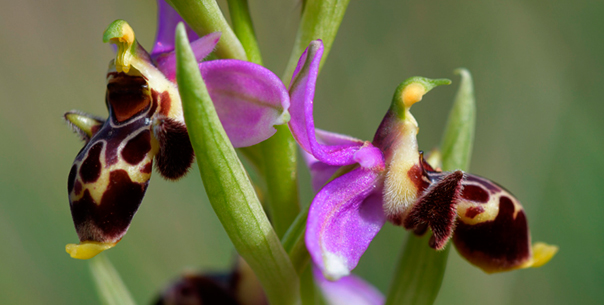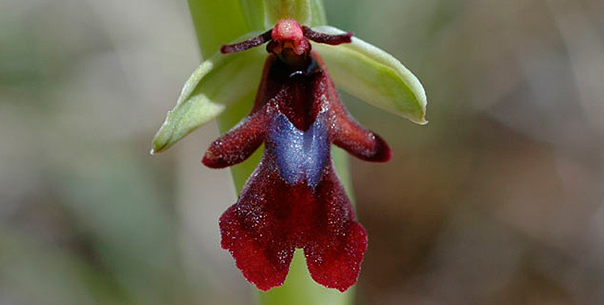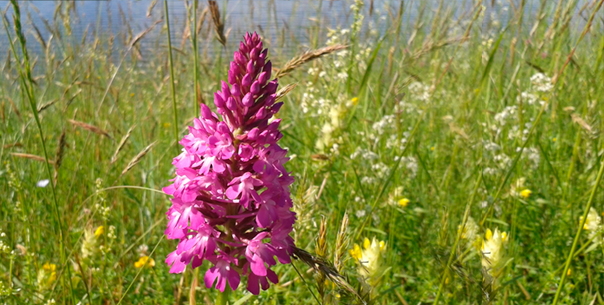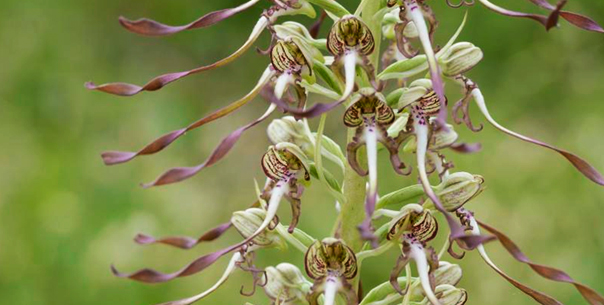Wild Orchids
amidst the vines
A preserved environment
For several generations now, we have been working to preserve the biodiversity of our terroir through an ISO 14 001 environmental management system. Here, we can find the elongated labellum serapias, the anthropophora “hanging man” orchis and the bee-fly ophrys.
“I delay cutting the grass in the vineyards and truffle-field as long as possible, to give the orchids as much time as possible to pollinate and disperse their seeds.
Tours to discover wild orchids (visible in season) depart every two hours from the château.
Cellar tours, wine tasting and on-site catering available.

Ophrys Bécasse
(Ophrys Scolopax)
It closely resembles Ophrys bee, but can be distinguished by a green appendage (mucron) at the tip of the brown labellum.
Sepals are often pink, rarely white or greenish, with a green midrib.
It owes its name to the shape of the silvery-brown spot edged with yellow, sometimes reminiscent of a woodcock’s eye. It blooms from mid-April to mid-June on hillsides and open woods in limestone soils.

Ophrys Petite Araignée
(Ophrys Araneola)
The flower of this orchid is small and insect-like. It owes its name to its brown labellum, spotted with an H-shaped macule and bordered by a fringe of yellow hairs. Sepals and petals are greenish, sometimes washed with brown.
Grows on limestone hillsides. The flowering period is very short, and the flowers quickly fade to a dull yellowish hue. This is the earliest of our orchids.

Ophrys Jaune
(Ophrys lutea)
This orchid of dry grasslands and open woods is easily recognized by the color and shape of its labellum. The labellum is three-lobed, rounded and has a very strong, bright yellow margin.
It is found in full sunlight on dry to cool limestone or siliceous substrates, lawns, wasteland, scrub and open woods. Flowering relatively early, it is particularly fond of arid limestone slopes, which are fairly common in the southern half of France.
Ophrys Abeille

Ophrys Mouche
(Ophrys Insectifera)
It owes its name to the shape of its purplish-purple labellum, characterized by a central bluish-gray spot that resembles the insect.
It’s a slender plant with spaced flowers, greenish sepals and short, brown petals that grow like antennae.
This plant blooms from mid-April to mid-June on limestone soils on hillsides and open woods.

Orchis Verdatre
(Platanthera Chlorantha)
It’s a large orchid with large oblong leaves (2 to 3) and a dense inflorescence of 10 to 30 fragrant, greenish-white flowers (up to 80 cm high). The vaguely white, yellow and green flowers are composed of a long, narrow labellum and a broad, overlapping dorsal sepal.
It flowers fairly well from mid-April to mid-June on the limestone soils of our hillsides and open woods.

Orchis Pyramidal
(Anacamptis Pyramidalis)
It owes its name to its typical pyramid-shaped inflorescence at the start of flowering.
The labellum is three-lobed and ends in a long, curved spur, with two protruding spurs at its base, said to direct the proboscis of pollinating butterflies.
It blooms from mid-April to mid-June on limestone hillsides, embankments and roadside verges.
Orchis Homme Pendu
(Orchis Anthropophora)
It owes its name to the shape of its flower, whose greenish-yellow sepals edged in red resemble a helmet, while the yellow-brown labellum is divided into filaments that resemble the body and limbs of a hanged man.

Orchis Bouc
(Himantoglossum Hircinum)
From the goat, it has the smell and the goatee. A robust, imposing plant (up to 80 cm high), it can’t be mistaken for any other.
The inflorescence develops into a dense spike, and the large, purple flowers give off their characteristic scent. It’s known as goat’s-beard loroglossa.

Céphalanthères
(Cephalanthera Longifolia)
This is a rare and fragile orchid, whose large white flower remains open for only a short time, letting in only small insects.
Arranged in spikes, the inflorescence is more or less dense, at the heart of rigid, elongated foliage, attached to the stem in two opposite rows, these are rhizome plants.

Sérapias à Long Labelle
(Serapias Vomeracea)
It’s a fairly tall, airy, robust orchid with large, tapering, violet-grey and greenish flowers. The purple labellum, elongated in the shape of a ploughshare, is covered with dense whitish hairs.
Very rare, this orchid blooms from mid-May to mid-June in more or less damp meadows.
Spiranthe d'Automne
(Spiranthes Spiralis)
It’s a small, inconspicuous plant with a single spiral inflorescence. The flowers are white, small and spurless.
It blooms from August to October in sunny lawns on calcareous or siliceous soils.
A unique collection
An annual 5-week event where 14 species of wild orchids thrive in a protected environment.
A unique place to discover this exceptional floral collection while tasting our vintages.
